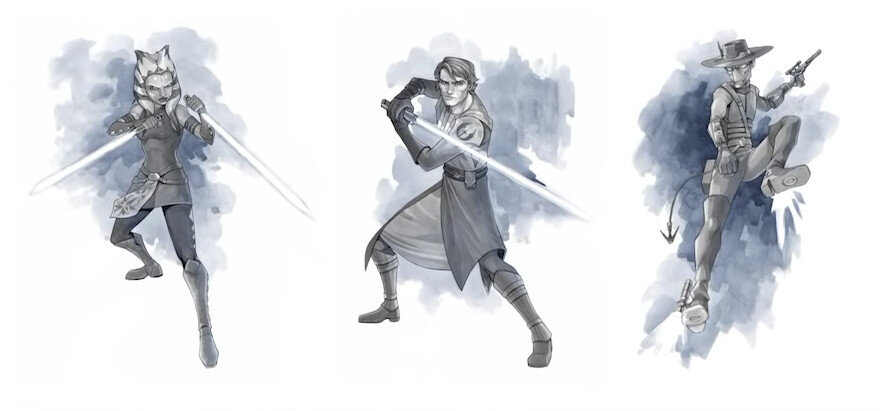By: Christian Corah
Descriptives
Page count: Hardcover, 352
Author: Various Authors
Intended Audience: Ages 8-12
Timeline: Follows Attack of the Clones, precedes Revenge of the Sith Main characters: All main characters from The Clone Wars
Brief synopsis: The time of the Clone Wars is a period of great conflict, and this book shares some of the time’s greatest stories.
Gut Feeling
I did not do my research on this book before reading it, so I didn’t know it was sort of a novelization of The Clone Wars. It obviously doesn’t cover the entire series, but some of the best stories from the series are told. I will say that the most popular arcs are not included, like Mortis, the Yoda arc, and Mandalore, but that is ok. I recognized some of the stories as my personal favorites, and I gained more appreciation for others. It was definitely an emotional roller coaster. I have been trying to rewatch the series, but as most of you know, it is a grind to do so. There are a ton of episodes, and some of them can be filler. This book is a great alternative to rewatching the series because it gave me a different perspective on some of the best episodes and arcs. Even though this book’s intended audience is young, I really enjoyed the read. The only downside is that the writing was simple (as it should be because of the intended audience) and there weren’t any new plot points within the stories. However, I didn’t expect there to be, I’m just being nit picky. I enjoyed the book so let’s get into the details.
Characters (8/10 pts)
This book covers a wide array of characters. We get stories from the perspective of protagonists, antagonists, Force users, and non-Force users. Because of that, there are many chances for characters to develop. However, because there are no new scenes added, there aren’t moments where characters can develop, but it doesn’t mean that they can’t develop within the scenes we are already familiar with. The book gives us a glimpse into what characters are thinking throughout the story, which lets us learn more about them. This is the obvious advantage of novels over movies and TV shows, and this book definitely took advantage of it. Another tool used in this book was developing characters through the perspective of others. We can learn a lot about a character about how another thinks of them. For example, Darth Vader got great character development in Rebels by how Kanan and Ezra reacted to being around him. This is how a character’s reputation is established. This book certainly did that for several characters (Ahsoka is the main one I think of). So, overall, despite not being able to add new scenes to the stories, the authors of this book did a great job developing characters. I am giving 8 points for this section.
Writing Style (8.25/10 pts)
There are a multitude of authors that wrote this book, this means that there are a multitude of writing styles. A lot of times when there is a book written by multiple authors, it is preferable that it seems like it is written by one author. However, considering this book, I’m glad that it was obvious it was written by different authors. Each chapter had its own style and it made the writing feel fresh and new. The stories were told in the traditional third person, first person from the protagonist’s viewpoint, and also first person from a secondary character’s viewpoint. Because we are already familiar with the stories, switching up how the stories were told kept it interesting. It is also important to note that the book is written for children, so the style overall is much simpler than what most of us are accustomed to. But I would be remiss to take away points for that. Overall, the writing style was slightly better than what I expected so I am giving 8.25 points.
Plot (7/10 pts)
I’ve mentioned it before, but the book doesn’t really add anything new to the plot that we are already familiar with and was already set in stone from the TV show. In novelizations, I usually look at what the book added to the plot with extra scenes. This can pull the entire stories together and fill in missing gaps. This book does not do that, but it didn’t really need to as the stories within the TV shows are more fleshed out than the movies. But this still means that the book won’t score great in this section because it is just retelling stories. However, there are still a couple reasons why this book will gain some points back. First, it pulled from the best stories within the series. If it pulled some from some of less popular arcs, the plot would not have been as strong. Second, the stories were told from different angles. This gives a different perspective on the story that we are already familiar with. This gives us a more complete understanding of what is happening. These are what the book did well, but it doesn’t fully overcome not being able to add new scenes. I am giving 7 points.
Intrigue (9/10 pts)
There were a multitude of things that added to the book’s intrigue making it the strongest section. First, because the stories told were some of the best within the series, there weren’t many low points in the book. Each chapter, which each included a different story, had an exciting story! They all had a slight build up with an exciting and climatic ending. Second, because most of us will be familiar with the story, it makes the reading go by easier. For the most part, we know what to expect while reading so it is easier to comprehend. Third, because the writing style is simple, it is not difficult to read much of the book in one sitting. If you are an active reader, this is certainly one that you can read in a single day or just a few days. However, because nothing new is added, I understand why that could take away from the intrigue. That is the one downside and is keeping the book from scoring even higher. Despite that, I am still giving a strong score of 9 points.
What does it add? (6.25/10 pts)
This is where the book is going to get its first real weak score. While I really enjoyed the read, it doesn’t really add anything new to the Star Wars universe. It is retelling stories that already exist within the universe and doesn’t add any new scenes. However, that doesn’t mean that the book adds absolutely nothing. Through some of the characters’ thoughts, specifically Yoda, we do learn a little more about using the Force. However, it really isn’t that substantial. This leaves the score for this section to be only 6.25 points, but it shouldn’t deter you from reading it.
Logic (0 pts)
There is nothing in The Clone Wars: Stories of Light and Dark that added to nor took away from the logic within the Star Wars universe. So, I am neither adding nor taking away extra points.
Final Thoughts
So, my final score for The Clone Wars: Stories of Light and Dark is a 7.7/10, or a C plus. This rating is slightly below average what I give Star Wars novels, but please don’t let that deter you from reading the book. If you love The Clone Wars, this is a great trip down memory lane! It is a much easier alternative than rewatching the entire series. Also, if you have not gotten a chance to watch the series, this also serves as a great introduction to the series. It highlights what makes the series so good. It is a quick and easy read and as long as you have even any interest in reading it, I think you’ll enjoy it! The only reason I can think of for you not wanting to read it is if you want something new to Star Wars. If so, there are other options available to youo. But I enjoyed this book, and it is likely that you will too.
I hope you enjoyed this book review and if there is a book that you want me to read or review, please let me know at christiancorah@gmail.com. As for now, I will only be doing Canon books (but in the future that might change).




